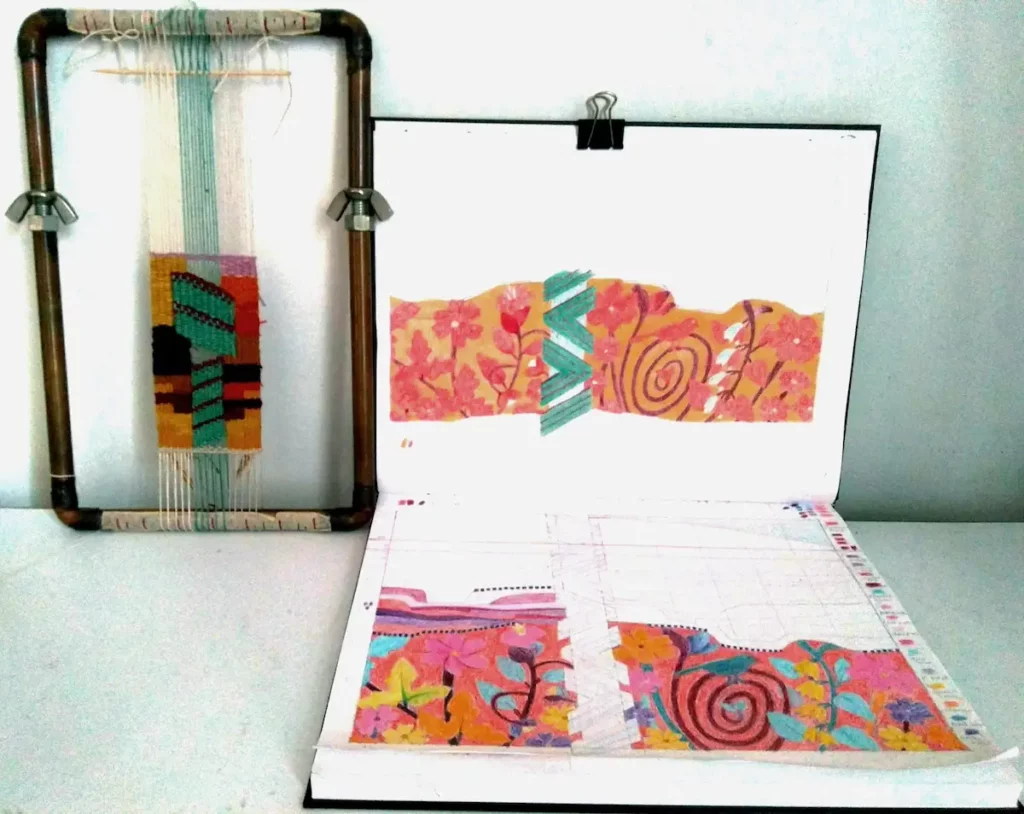Jennifer Sargent is a textile artist and weaver originally from England who began her artistic journey in college. She evolved from working within commercial constraints to finding freedom in her art, weaving tapestries and creating drawings that tell powerful stories.

How did you get started making art? Why do you do it?
I started at art college in England as a textile artist, primarily a weaver but also always drawing. My training was based on the Bauhaus principle of working on hand looms, developing ideas to be used by industry.
In college we were encouraged to be as creative as possible and to challenge the perceived limitations of the loom. I loved solving the puzzles posed by weaving, the intensity of color possible with yarns and the way different textures were created by the weave structure and in the yarns.
After college, I soon realised that working as a commercial textile designer meant designing more narrowly, always within the customer’s parameters, and with deadlines that were always “yesterday”.
As an Amazon Associate I earn from qualifying purchases. Read more about our affiliate linking policy.
Eventually, moving to New York, I began to expand my own creative boundaries again, to ask and answer my own questions.
Tapestry found me in the middle of a loud, fast city where I discovered the subversive pleasure of working slowly and savoring the process of making woven art.


Describe your creative space.
I work in a fairly small room in my house. It’s a labyrinth of spaces that includes two large looms, as well as table space, drawing materials and yarns. I am surrounded by color and bits of inspiration – fabric, postcards, books. I concentrate on one piece at a time, mostly because I do not have room for multiple projects but also because in this cluttered space I focus better when working that way. At the end of a project the room is cleared away leaving a literal and imaginative space ready to start the next project.


Recently, when I was given a much larger studio as part of a three month residency at Crosstown Arts in Memphis I found that by having so much more space, being able to spread out on tables and walls, I enjoyed working on multiple projects at the same time – something to keep in mind for the future.
Can you tell us about the inspiration and process of one of your works? How does a new work come about?
I have two examples to share, one concerns tapestry and one drawing.

“Sometimes a Journey” is a recent tapestry piece created after the destructive California fires. I wanted to highlight the contrast between our natural world being consumed by fire and the pressing weight of society.



I gradually developed these ideas by drawing in my sketch book and weaving many samples, playing with yarn, color and weave structure. Stepping back and looking at what I had done, which is an essential part of my practice, I saw that one more element was needed to show some hope for change. I added a more open area that thrusts through the tapestry, disrupting these opposing forces.
“Folly and Falsehoods” a laser cut drawing, evolved from my time in the Crosstown Arts Residency where I was introduced to the laser cutter in their Makers Space. I had time to experiment with different papers and mediums, to make finished drawings and alter them by cutting through with different patterns.
“Folly and Falsehoods” was the result of a challenge from Six Points, a group of artists I belong to, who meet regularly to support and critique each other’s work. We decided to collaborate by having one artist talk to another and respond to one of their pieces. My drawing would not exist without this conversation.
The idea was inspired by two different thoughts, quilting and a disruption of the surface and the layering that happens in the environment under trees. My initial drawing was colorful, showing trees and their environment. My laser cut pattern referenced quilt patterns but cut through the edge of the drawing disrupting its tranquility. I added more grey layers of the cut pattern, disturbing the composition’s balance.
My intention is to give the feeling of “koyaansqatsi” (Hopi for life out of balance) showing the shadows of development and climate change that are overtaking our landscapes.

What do you do differently? What is your signature that makes your work stand out as yours?
I am known for my imaginative use of color and for enhancing these color effects by juxtaposing different warp densities. By creating finer and coarser weaving in the same tapestry a subtle play of shadows occurs across the whole tapestry surface. I also use an ancient Coptic weaving technique where a floating weft is taken over the surface and inserted into another part of the tapestry giving a strong outline or emphasis to a shape or area.

When it comes to creating, are you more of a planner or an improviser?
I fall in the middle between planning and improvising. Weaving for me is thinking but because tapestry is built from the bottom up, thread by thread, and cannot be erased along the way, I want some sense of where I am going but I also want to allow the weaving to speak to me. I want to be surprised but I have to be looking and listening to catch that voice. It can be very quiet.
Where can people find your work?
Website: https://jennifersargent.weebly.com
Instagram: @jennifersargentstudio
Facebook: www.facebook.com/jennifer.sargent524
Jennifer is a member of Tapestry Weavers South.
Interview posted October 2023
Browse through more weaving inspiration on Create Whimsy.

